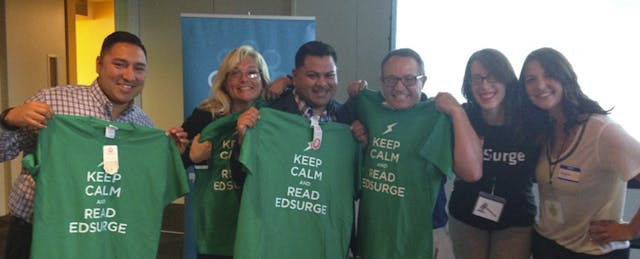On June 18, educators, entrepreneurs and edtech enthusiasts gathered at the EdSurge SF Edtech Meetup for the great debate: Which company offers the best learning ecosystem for the classroom: Apple, Google or Microsoft?
Our panelists included: Martin Cisneros, Academic Technology Specialist at Santa Clara County Office of Education; Angela Mecca, Regional Manager of Education at Google; Jon Corippo, CUE Director of Academic Innovation; Diane Darrow, Director of Educational Technology at Archbishop Mitty High School; and Elijah German, Microsoft Business Sales Specialist.
These educators and company reps defended their allegiances in four categories: devices, software, BYOD, and PD and infrastructure. And they weren’t shy. There was scoffing. There were rumors. There was even mention of—gasp—the rollout at LAUSD.
Devices
Apple’s advocates argued that their products are versatile for different needs in different grades. “What I like is a layered approach,” explained Corippo. “You can put kids on iPads in early grades, and transition to Macbook Airs for high school, when they want to use professional tools like FinalCutPro.” Darrow added her view that iPads are ideal for project-based learning: “When gathering information in the fields, with an iPad, you can combine all that data on one device. From that, students can create their own content, not just be consumers online.”
But where Microsoft wins, German replied, is in the range of pricing options available: “From a competitive standpoint, the price point is there for a range of budgets, from the Surface to smaller Acer devices.”
Software
In terms of reaching students with diverse backgrounds and varying access, Mecca sees Google as the clear winner. “With the entire ecosystem of Google products, Chromebooks are easy to scale, and easy to customize,” she said. “Students have a customized learning environment no matter what device they log into, which makes an especially big difference for students who aren’t in a 1:1 environment.”
But German countered that with its wide use in companies, Microsoft software best prepares students for future careers. “Office 365 prepares students for life after K-12, beyond being a designer or a developer,” he explained. “Every company uses Microsoft Office.”
We need to prepare kids with skills for a changing world, not just how to use a tool @ang_mecca from @GoogleForEdu #sfedtech
— EdSurge (@EdSurge) June 19, 2015
Not all the panelists agreed that hard skills like Microsoft Office are the best way to prepare students for the workforce. “It’s an unpredictable future—think about what software will look like in 2030, when today’s kindergarteners graduate high school,” countered Mecca. “Google Apps focuses on how students are thinking and learning, rather than teaching them to use a specific device or system” like Microsoft 365.
PD and Planning
“There’s nothing easier than a Google deployment,” asserted Cisneros, who has assisted over 20,000 Google deployments in schools. Mecca agreed, bringing up the PD support that Google provides. “We’ve built out the Google for Education training center with different levels,” she explained, to walk teachers through learning what a Google Doc is, to integrating it effectively in the classroom. Corippo—a member of Team Apple—actually agreed, admitting, “Google offers the best PD, for free, online—they’re in the lead on that one."
But as an educator, Darrow disagreed. “I don’t have time for all that PD,” she explained, pointing to Apple products as more intuitive for users without PD support. “The iPad is a lot like my phone, so I can get on there and figure out how to use it on my own.”
All the panelists agreed on the pivotal role of thoughtful planning before implementation. “You need to do deployment in waves,” said Corippo. “Nothing scares me more than a superintendent coming in with technology and saying, we’re going to implement this all at once. Do the legwork beforehand, and start out with one grade level!”
Have a vision for what & why you're bringing devices into your classroom or they're just shiny gadgets- @dianedarrow #sfedtech
— Jess Falkenthal (@Jfalkenthal) June 19, 2015
“LAUSD is a perfect example of why planning has to come first,” added Darrow. “Otherwise you just have a bunch of little gadgets with no purpose."
BYOD and Infrastructure
Good-natured debating aside, the panelists agreed that no matter the device, students need to be equipped with the relevant technology skills to succeed in the future. Several panelists saw this as best accomplished through a combination of platforms and systems.
“As long as kids have multiple options, that’s key—I don’t want a kid to graduate high school and say, I’ve only ever used this one kind of thing,” said Corippo. “My take is, the ideal is using Google stuff on Apple stuff. If I have an Apple device and a Google Apps for Education account, I’ve got the best of the best.”
Darrow brought up concerns about BYOD shared by many educators and parents. “What worries me about BYOD is equity, and making sure you have the device for a child’s learning needs,” she explained. “Each child is different, and you have to make sure everyone has access to the same level of accessibility features. For example, Apple is amazing in terms of assistive technology and taking care of students with disabilities and challenges."
An even more fundamental problem than the device question is making sure that schools have the proper bandwidth. “We’ve got to get our schools online first,” she cautioned. “Any provider that offers devices without proof of infrastructure and support—that’s highway robbery. Nobody looks for that proof, and that’s wrong.”
Cisneros ended the evening with a powerful reminder of the role tech can play in the classroom. “As long as a device is in a student’s hands, and helps them make and create, it’s a great time to be an educator and a great time to be a student,” he said. We couldn’t agree more.
Check out more thoughts from our debaters on the live Twitter feed. And read more opinions from educators about Google, Apple and Microsoft products, or listen on the EdSurge podcast!


